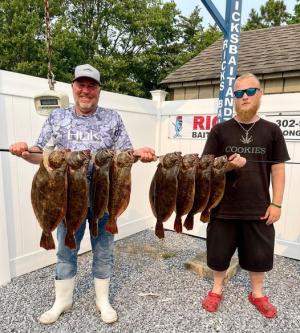While the season is just getting started, the results of flounder fishing at the Old Grounds are encouraging. There have been limit catches from private and charter boats, with some keeper sea bass mixed in with the flounder.
Speaking of sea bass, back in the day, the Old Grounds was the area where commercial fishermen put their sea bass pots. There were so many that we called it the Flags. We didn’t fish there for sea bass. We trolled Hoochies for big bluefish. Charter boats could run two trips a day, and private boats often caught more blues than they needed, and I am sorry to say the excess ended up in garbage pails.
Big blues are in a down cycle, global warming has moved the sea bass farther offshore and now we have flounder at the Old Grounds.
So where exactly are the Old Grounds? According to Captain Segull’s Sportfishing Chart, the Old Grounds are located at N 38 34.388, W 74 47.758. That is as good a starting location as any, but the Old Grounds cover a wide and long area between B and A buoys. There is even a good bottom area west of A Buoy where I have caught both flounder and sea bass.
If you are new to fishing for flounder at the Old Grounds, I would suggest you run out to those numbers and begin fishing with your favorite flounder rig. Mine is a Captain Mitchell Delaware Bay Green Machine with a live minnow and either a strip of squid or a Gulp! twister tail. Another is a bucktail heavy enough to reach and stay in contact with the bottom, baited with a nice Gulp! twister tail.
Keep an eye on the sonar and note any changes in the depth, especially any sharp drops or upwellings. When the first flounder comes over the rail, hit that MOB button on the GPS. Once the excitement settles down, go back and drift the same course as you did when that flounder was caught. Continue to make that drift until no flounder are taken. Repeat this routine after every flounder catch. Leave the position on your GPS because you know that spot holds flounder.
As the day goes on and you catch more flounder and record more MOBs on your GPS, be sure to note the wind and current directions. These two factors determine how you drift, so they are important considerations when planning your next trip.
Now, I have said the Delaware Bay Green Machine and a bucktail were my go-to rigs for flounder at the Old Grounds. Never satisfied with my current equipment, I have purchased two squid imitations from two different companies. I bought them over the winter and have yet to try them out. I hope to get out to the Old Grounds soon and give them a workout.
Always remember that flounder are ambush feeders. They lie in wait for their prey to pass by, then explode out of their hiding place and grab their target. As they move off, you have to give them some slack until they turn the bait in their mouth and begin to swallow; then you can set the hook. I use circle hooks, so I just let the line come tight and the fish is on.
As I said, the Old Grounds stretches from B to A buoys so there is plenty of space to fish. Not all of that bottom is good, but you can feel if you are over the rocks or back on smooth sand. Both may hold flounder, but I have found the rough rocks hold more and bigger fish.
The Old Grounds are in the open ocean, and subject to the wind and waves. If the wind is over 10 knots and the seas are over 2 feet, find somewhere else to fish. Sure, you can fish out there when it’s rough, but trying to hold bottom with 8 to 10 ounces while trying to hold onto the boat with one hand and holding the rod with the other does not leave you many choices when it comes to cranking in a fish.
I like to leave early, say clear the inlet by 6 a.m., and come in around 2 or 3 p.m. This allows me to fish while the wind is as calm as it is going to be on any given day. By late afternoon, even on a calm day, the heat of the land and the cooler ocean water will set up a breeze that can make the ride home a bit sporty, to say the least. Then you have the risk of an afternoon thunderstorm. That’s when the joker on the VHF says to seek safe shelter and you are 15 miles east of the inlet.























































